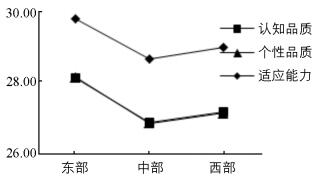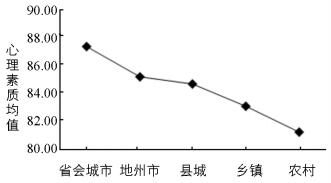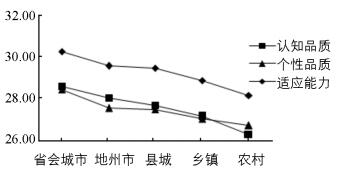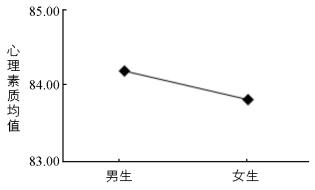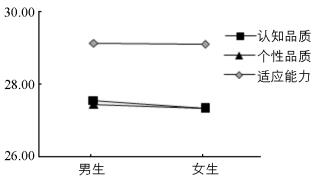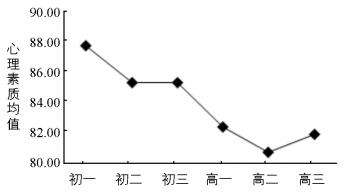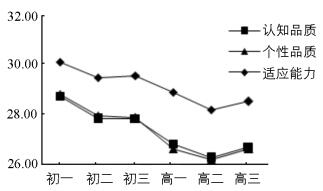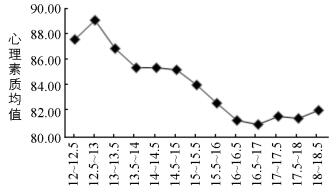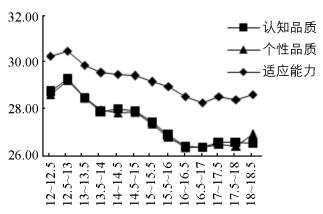全文HTML
-
心理素质是学生素质的重要组成部分,随着我国素质教育的推进,良好心理素质的培育日显重要。青少年心理素质的提高既是学校心理健康教育的目标追求,又是中国特色心理学的重要研究领域[1]。
中学阶段是童年向成年过渡的时期,从11、12岁开始到17、18岁结束,历时6年。这一时期个体正处于青少年时期。在这一时期,个体在生理、认知和社会性方面均产生了巨大的变化。尤其在青春期,个体生长发育进入高峰期并趋于成熟,但心理发展的速度却相对缓慢,身心发展的不平衡容易引发诸多心理矛盾,成为青少年心理问题产生、变化的内在根源,从而严重影响其健康成长[2]。
心理素质的培育是从根本上解决青少年心理问题的基本途径[3]。学生的素质主要包括生理素质、科学文化素质、思想道德素质和心理素质。其中心理素质不仅是整体素质的重要组成部分,而且是制约其他素质形成和发展的中介变量[4]。我国研究者从结构-功能的角度解释心理素质的内涵,在理论探析和实证考察的基础上,将心理素质界定为“以生理条件为基础的,将外在获得的刺激内化成稳定的、基本的、内隐的,并具有基础、衍生、发展和自组织功能的,并与人的适应-发展-创造性为密切联系的心理品质”[5]。从根本意义上说,心理素质是一种稳定的心理品质,对青少年的心理健康、学业发展、人际交往等个性和社会性的发展起决定性的作用[6]。以青少年心理健康为例,根据王鑫强和张大均[7]提出的心理健康与心理素质的关系模型,心理素质属个体的内在机制,心理健康为外显的行为表现和心理状态,两者之间为相互关联的层级关系。心理素质作为内源性因素,能够调节外部刺激因素对个体心理健康水平的影响[8]。因此,心理素质是青少年心理健康维持和发展的关键。
从结构—功能的角度来看,心理素质是个体心理和行为的内容要素与功能价值的统一体,根据对个体心理活动和行为实践作用的不同,内容要素可分为认知品质和个性品质。其中,认知品质表现在人对客观事物的反映活动中,直接参与对客观事物认知的具体操作,是心理素质的基本成分。个性品质是个体心理特征的组合,虽不直接参与对客观事物认知的具体操作,但具有动力和调节机能,居于心理素质的核心地位。心理素质的功能价值即适应性(能力),它以一定的心理特征要素(认知品质和个性品质)为基础,通过与社会环境交互作用—选择、适应和改变环境,使自身与环境和谐协调的能力[4-5, 7]。由此可知,认知品质、个性品质、适应性(能力)是心理素质的三个不同层面,三个层面之间相互作用、动态协调发展,共同构成了心理素质这一自组织系统[6]。
在前期研究的基础上,根据心理素质的理论和双因子结构理论,武丽丽,张大均和程刚[9]将双因子模型引入心理素质的研究领域,通过理论分析并与传统维度结构模型进行比较,最终证明了中学生心理素质双因子结构的科学合理性,构建了中学生心理素质的双因子结构。基于此,胡天强,张大均和程刚[10]在已有的多版中学生心理素质问卷基础上进行修订[11-12],形成了中学生心理素质量表(简化版)共24个题项,并对量表的信度(内部一致性信度、重测信度)和效度(结构效度、效标效度)进行了检验,结果表明,修订后的量表结构清晰、使用简便,信效度均符合心理测量学标准,适用于评定中学生心理素质的发展水平和特征。但由于样本的分布区域比较局限,缺乏全国中学生心理素质的分布状况和参照标准,因而难以准确的衡量个体心理素质水平在所属群体中的相对位置,无法对个体的量表得分做出科学、有效地解释。另一方面,心理素质教育评价是心理素质教育的重要环节,然而由于缺乏评价标准,目前对于心理素质教育评价的研究基本处于空白[13]。
本研究旨在将中学生心理素质量表(简化版)运用于全国中学生群体中,获取更具代表性的大样本资料,通过比较心理素质在经济带、家庭居住地、性别、年级、年龄段等人口统计学变量上的差异来探讨中学生心理素质发展变化的特点,最终建立中学生心理素质量表(简化版)的全国常模,从而为个体量表分数的解释以及学校心理素质教育的评价提供参照标准。
-
本研究综合考虑我国三大经济带、年级、性别比例,根据分层抽样的原则,计划抽取样本量为25 200人。其中三大经济带是我国第七个五年计划时期根据各地区的自然条件、经济资源、经济发展水平、交通运输条件、经济效益等方面的差异,划分的东部、中部、西部三大经济带。东、中、西部学校的比例、年级比例以及性别比例均依据中华人民共和国教育部官方网站权威发布的2015年教育统计数据。全国抽样工作于2016年10月份开始,2016年12月底完成。本研究最终收回问卷24 569份,进行编码整理后,以量表为单位,删除缺失值超过30%或规律作答的无效问卷,保留有效问卷22 827份,有效率为92.91%。最终抽样分布如下:按照经济带,东部地区(江苏省、天津市、广东省、浙江省、北京市、河北省)7 408人(32.45%),中部地区(江西省、湖北省、河南省、湖南省、安徽省)7 076人(31%),西部地区(四川省、重庆市、贵州省、陕西省、云南省)8 343人(36.55%);按照家庭居住地,省会城市3 945人(17.28%),地州市(地级市或自治州)2 144人(9.39%),县城5 075人(22.23%),乡镇3 336人(14.61%),农村6 625人(29.02%),家庭居住地栏缺失1 702人(7.46%);按照年级,初一年级3 933人(17.23%),初二年级3 825人(16.76%),初三年级3 773人(16.53%),高一年级4 346人(19.04%),高二年级3 636人(15.93%),高三年级3 314人(14.52%);按照性别,男生10 307人(45.15%),女生11 333人(49.65%),性别缺失1 187人(5.20%);按照以半岁为间隔的年龄段划分,12~12.5岁1 011人(4.43%),12.5~13岁1 329人(5.82%),13~13.5岁1 584人(6.94%),13.5~14岁1 703人(7.46%),14~14.5岁1 756人(7.69%),14.5~15岁1 666人(7.30%),15~15.5岁1 961人(8.59%),15.5~16岁1 998人(8.75%),16~16.5岁岁2 197人(9.62%),16.5~17岁1 630人(7.14%),17~17.5岁1 719人(7.53%),17.5~18岁1 172人(5.13%),18~18.5岁979人(4.29%),年龄缺失2 122人(9.30%)。将实际样本采集的人口学资料比例(如年级、性别)与教育部官方网站权威发布的2015年教育统计数据比例进行卡方检验,结果显示差异均不显著(χ2=0.532,df=5,p>0.05;χ2=0.004,df=1,p>0.05),表明本次抽样具有较好的代表性,能够代表全国中学生群体。
-
本研究采用胡天强等[10]修订的中学生心理素质量表(简化版)。该量表由24个题项组成,分为认知品质、个性品质、适应性(能力)三个维度,其中认知品质主要包括意识性、监控性、好奇性、目的性、应变性和迁移性等;个性品质主要包括坚韧性、自制性、独立性等;适应性(能力)主要包括人际适应性、社会适应性和应激情境适应性等。每个维度8个题项。量表采用5级计分(从“1=非常不符合”到“5=非常符合”),分数越高表明被试的心理素质水平越高。总量表的内部一致性系数为0.912,间隔4个月的重测信度为0.615,各维度的内部一致性系数在0.763~0.831之间,重测信度在0.549~0.637之间。结构效度(CFI=0.948,TLI=0.937,χ2/df=4.19,RMSEA=0.036,SRMR=0.029)、效标效度均达到了心理测量学的要求。在本次全国样本调查中,心理素质总量表的内部一致性系数为0.923,分维度认知品质、个性品质、适应性(能力)的内部一致性系数分别为0.852,0.826,0.806。
-
以班级为单位进行团体施测,采用匿名方式,由本专业的教师和受过专门培训的班主任实时实地完成样本的调查,当场收回并装袋密封。
-
运用SPSS24.0对数据进行分析,主要进行描述统计、t检验及方差分析。
一. 常模取样
二. 测量工具
三. 施测程序
四. 数据分析
-
首先对来自全国的22 827名中学生的心理素质总分、分量表得分分布进行分析。根据量表的计分方式,心理素质总量表的得分在24~120之间,分量表得分在8~40之间。表 1是心理素质总量表及分量表的数据特征。
-
为进一步检验中学生心理素质总量表及其分量表均分在不同经济带、家庭居住地、性别、年级、年龄段等方面的差异性,分别以各类人口学变量为自变量,心理素质总均分、分量表均分作为因变量,进行方差分析。结果如表 2所示,中学生心理素质及分维度的发展水平均存在显著的经济带差异、家庭居住地差异、年级差异和年龄段差异;在性别上,男女生心理素质的发展水平不存在显著的差异,但在分维度认知品质上,男生的发展水平显著高于女生,其余分维度均不存在显著的差异。
图 1-图 10展示了心理素质及分维度在各人口学变量上的变化趋势,进一步的多重比较发现:在经济带上,中学生心理素质及分维度的发展水平从高到低依次为东部、西部、中部(p<0.001);在家庭居住地上,除地州市中学生的发展水平与县城中学生无显著差异外(p>0.05),其余均存在显著差异,中学生心理素质及分维度的发展水平由高到低依次为省会城市、地州市(地级市或自治州)和县城、乡镇、农村(p<0.001);在性别上,男生认知品质的发展水平显著高于女生(p<0.01);在年级上,初中生的心理素质水平显著高于高中生(p<0.001),进一步比较各个年级发现,初一学生心理素质及分维度的发展水平显著高于初二与初三学生、高二学生的心理素质及分维度的发展水平显著低于高一与高三学生(p<0.001),初二与初三、高一与高三之间则不存在显著差异(p>0.05);在年龄段上,心理素质及分维度的发展水平整体呈现下降趋势,除12~12.5岁与13~13.5岁之间,13.5~15岁之间所有的年龄段,15.5~16岁与18~18.5岁之间,以及16~18.5岁之间所有的年龄段不存在显著的差异外(p>0.05),其余年龄段之间均有显著差异(p<0.01)。
-
表 3列出了中学生心理素质的经济带常模、家庭居住地常模、性别常模、年级常模和年龄常模。
一. 中学生心理素质量表(简化版)的总体常模
二. 中学生心理素质及分维度的人口学变量差异分析
三. 中学生心理素质量表(简化版)的各类型常模
-
依据教育部官方权威发布的相关教育统计数据(如经济带、性别、年级比例),采用分层抽样法在全国范围内进行调查,对最终获得的22 827名中学生有效样本进行分析。从整体来看,数据基本为正态分布,卡方检验的结果表明,样本在经济带、性别以及年级上的分布与教育部发布的数据无显著差异,表明本次取样方法科学,该量表的常模样本具有较好的代表性,其结果能够代表全国中学生心理素质的整体发展水平。
在经济带上,本研究发现中学生心理素质及分维度的发展水平存在显著差异,由高到低依次为东部、西部和中部。这与小学生全国样本的调查结果相一致。改革开放以来,我国实施的东部率先发展战略促进了东部经济的高速增长,而西部也得益于西部大开发战略的实施,经济增长明显加快。中部地区面对东部的繁荣和西部大开发的夹击,经济增长速度最为缓慢,当前中部崛起的区域政策虽然出现了发展势头较好的新格局,但由于历史、文化、社会、政治等多方面的因素,区域间经济发展仍不平衡。经济的增长与教育的发展具有很强的内生互动性,经济发展水平决定了教育投入的规模[14]。东部的教育投入一直较多,远远超过了中西部,2000年西部大开发战略提出后,西部的教育投入大幅度增加,远远超过了中部。教育投入是教育发展的基础[15],在心理健康教育方面,东部启动较早。教育部颁布《中小学心理健康教育指导纲要(2012年修订)》后,中小学心理健康教育已得到各级各类学校的广泛重视,取得了积极成效。特别是东部沿海地区,心理健康教育进一步得到重视,并取得令人瞩目的成效[16]。心理健康教育旨在培养学生良好的心理素质,因此,学校心理健康教育发展的不平等可能是导致中学生心理素质发展水平在经济带上存在显著差异的原因。
在家庭居住地上,中学生心理素质及分维度的发展水平由高到低依次为省会城市、地州市(地级市或自治州)和县城、乡镇、农村。伦敦大学的一项调查证实了影响学生学习成就的最大因素是学生的家庭住址,而非学校的类型[17]。社会阶层因素主导着教育,当前我国处于社会经济的快速发展与转型时期,城乡差距不断扩大,城市贫富差距也相当巨大,社会的基尼系数长期在高位运行。家庭社会经济地位是衡量家庭在社会阶层中的核心指标,对青少年发展具有广泛而深刻的影响[18]。大量研究表明家庭经济地位与学生的认知发展、情感发展、学业成绩和心理健康之间存在相关,来自高家庭经济地位的青少年拥有更多的发展资源 。根据布朗芬布伦纳[21]的生态系统理论,家庭社会经济地位可以通过父母教养方式来间接影响学生心理素质的发展[22]。
中学生心理素质的发展水平不存在显著的性别差异,这与王鑫强[8]的追踪研究结果相一致。在分维度上,男生认知品质的发展水平显著高于女生,而其他分维度则没有显著的性别差异。女生的生理发育和心理发展都早于男生,但随着青春期的到来,性别差异逐渐变小[23]。Lynn[24]的智力性别差异发展理论认为,青春期初期,女生在大脑容量上的发展速度快于男生,但到了16岁左右女生的发展速率与男生相比,优势已经不在,男生的大脑容量优势得以凸显。由此开始,男生在智力平均得分上会逐渐高于女生,并达到显著水平。冯正直等[11]对中学生心理素质特点的研究也发现男生的创造性显著高于女生。王鑫强[8]认为男生在创造性等认知因子上的得分显著高于女生可能与其生理特点、性别角色特点、家庭与学校教育方式、社会文化和教师的期望等有关。
在年级上,心理素质及分维度的发展整体呈现随年级升高而下降的趋势,初中生的心理素质水平显著高于高中生。这与王极盛,卢家楣,王鑫强等人的研究结果相一致[8, 25-26]。青少年处于发展的特殊时期,随着生理上发生巨大的变化,心理整合的持续性环节和统一性环节上均出现了暂时的混乱,情绪不稳定,逆反心理强,自尊心强,自我控制能力和心理承受力较弱,需要面对的压力和烦恼逐渐增多,社会支持却呈现随年级升高而降低的趋势[8],因此极易引发心理发展上的矛盾,并进一步产生内部心理问题,如抑郁、焦虑等[23]。李东梅[27]的研究表明青少年在面临情绪事件时所体验到的感情强度随年龄的增长而增长,尤其在高中阶段。青少年时期的这一系列变化可能是造成心理素质水平出现下滑的原因。另一方面,这反映出从初中段到高中段,学校素质教育比重呈下降的趋势,高考升学率的压力可能是造成学校忽视心理素质培养的原因[8]。
具体对各个年级进行分析发现,高二年级学生心理素质的发展水平处于最低谷。王鑫强[8]的追踪研究也表明,在高中阶段,学生的心理素质呈“V”字型发展态势。高二上学期划分文理班,学生由于学习环境、学习方式、人际关系的变化,很容易出现各种不良的应激反应[28],如有研究表明高二年级是学业不良情绪上升的重要时期[29],家庭支持和其他支持水平在这一时期却全面下滑[8],这可能是造成高二学生心理素质水平降低的原因。
在年龄段上,心理素质及分维度的发展整体上呈现出下降的趋势。这与心理素质在年级上的变化趋势相吻合。具体在12~12.5岁短暂上升,12.5~13.5岁下降,13.5~14.5岁平缓,14.5~16岁下降,16~18.5岁平缓的趋势。12到14岁青少年正处于青春期,个体身体发展进入加速期,但心理发展速度相对于生理发育速度来说相对平缓,思维方面,抽象逻辑思维水平还较低,在人格特点上,缺乏深刻而稳定的情绪体验,缺乏承受力、克服困难的意志力,社会经验也十分缺乏[23]。因此造成了青少年身心发展的矛盾,使他们面临一系列心理危机。12~12.5岁出现短暂的上升,可能与出现脑发展的加速期有关。14.5~16岁心理素质水平骤然下降,这一年龄段恰好与初三到高一的衔接时期相对应。以往对中小学生心理素质发展特点的研究已表明,在各学段前后衔接时期,学生的心理素质发展一般较差[30]。16~18.5岁心理素质的发展趋于平缓,这是由于在这一阶段中学生进入青年早期,个体在生理发育上已达到成熟,在智力发展上接近成人,并在个性及其他心理品质上表现出稳定的特征[23, 31]。
总体而言,本研究在对抽样数据统计分析的基础上建立了我国中学生心理素质的常模。有效常模样本通过在全国范围内分层抽样获得,样本量为22 827人。样本在经济带、性别和年级等人口学变量上的分布比例与教育部权威发布的教育统计数据相吻合,表明本次抽样具有良好的代表性。对样本的特征分析发现,本研究结果与以往中学生的相关研究结论基本一致,并与青少年的心理发展规律相符合,表明本次建立的常模具有科学性、有效性,可广泛应用于我国中学生心理素质的测量与评估。另一方面,评价是整个教育中枢系统的关键环节,本次常模的制定为学校心理素质教育的评价提供了客观、科学的参照标准。素质教育的深入开展迫切要求加强心理素质研究,常模的制定也为进一步深入开展学生心理素质研究奠定了基础,这对于推进我国心理素质研究和素质教育具有重大的意义。



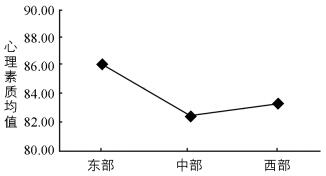
 下载:
下载:
